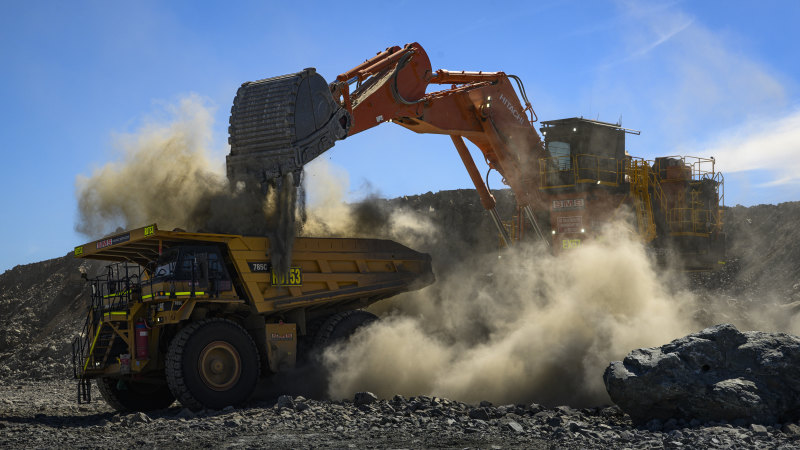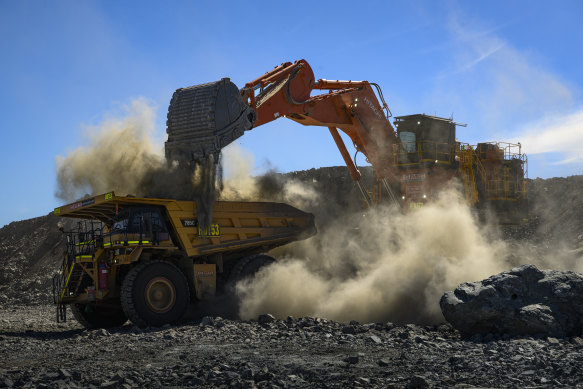‘We would be a superpower’: Australia’s next gold rush beckons

By Mike Foley
Save articles for later
Add articles to your saved list and come back to them any time.
Australia’s rock star economy has churned out the hits for two centuries, from the 1850s gold rush to the 1970s export bonanza for coal and iron ore, which boomed again in the early 2000s with gas exports adding to the chorus of dollars being counted.
Prospects for a new chart-topper hinge on a clutch of so-called critical minerals needed for the world’s clean-energy revolution, with revenue from commodities such as lithium, cobalt and rare earth elements forecast to overtake coal exports by 2028.
But in pursuing this market, the nation is quietly tipping into the middle of a battle between the United States and China over global critical mineral supplies.
How it navigates this challenge and grasps the opportunities ahead could determine if Australia’s economy, like its other biggest rock export, AC/DC, stays back in black, or fills discount bins for years to come.
China has spent decades strategically investing to dominate the global supply of minerals that are crucial to building the clean technologies that are now needed to decarbonise the world’s economy, such as batteries, wind farms and solar panels.
It owns more than 80 per cent of global rare earth supplies and processes more than 95 per cent of the world’s rare earth ore. Where China does not dominate supply of raw minerals, it imports them and dominates their processing.
China’s market strength exposes Australia to considerable risk. While Australia produces about half the world’s lithium ore, it sends nearly all of it — 97 per cent — to China for processing.
China is not afraid to disrupt global supply chains. It has restricted exports of minerals such as gallium, graphite and germanium as it flexes its Asian superpower muscles.
The Albanese government is mapping out its vision to capture a larger slice of the coming critical minerals boom that the energy revolution promises to deliver with plans to invest massive amounts of public money.
It wants to ditch Australia’s reputation as Asia’s quarry by creating a local processing industry – significantly value-adding to critical minerals mining revenue. And it wants Australian-made batteries.
Critical minerals are those that countries deem essential for technologies, the economy, national security, or because their supply chains are vulnerable. Australia’s list includes lithium, nickel, cobalt, manganese and graphite, essential for batteries, as well as rare earth elements crucial for the permanent magnets used in wind turbines and electric vehicles.
Demand is set to soar for decades. Electric vehicles require six times more minerals than conventional vehicles. Offshore wind turbines require 13 times more mineral resources than a similarly sized gas power plant.
Australia has 27 per cent of the world’s known lithium resource, 22 per cent of nickel, and 21 per cent of cobalt, according to the Grattan Institute.
Demand for lithium is expected to grow by up to 41 times by 2040, while the value of both the nickel and cobalt markets is expected to increase 30 times, Grattan said in a report earlier this year. Lithium, nickel, and cobalt represented an enormous economic opportunity for Australia, it wrote.
Lithium ore is loaded into trucks inside the quarry owned by Pilbara Minerals in Western Australia. Credit: New York Times
Federal Resources Minister Madeleine King says China is three decades ahead of the rest of the world when it comes to the supply of critical minerals. “Most of the Western world thought we could outsource and offshore minerals processing,” King says. “We should have been doing it before, to be quite frank. Now’s the time for Australia to compete using its natural advantage.”
On November 2, Treasurer Jim Chalmers gave a landmark speech that was widely reported as a warning that Australia was not on track to reach its goal of net-zero greenhouse emissions by 2050. In fact, Chalmers was adding some much-needed detail around the government’s made-in-Australia vision, days before Prime Minister Anthony Albanese visited China.
Chalmers said Australia would invest in local green industries, signalling a new era of competition with China, and flagging Australia’s plan to collaborate with the US on breaking down China’s dominance in critical minerals.
The US is taking on China through its gargantuan Inflation Reduction Act (IRA), which some analysts believe could deliver up to $US1 trillion ($1.56 trillion) in industry subsidies and has been described as a “global capital vortex” sucking up green investment from all over the world.
The Biden administration has signalled that US companies investing in Australian critical minerals projects will be considered for subsidies on equal terms as those investing in projects in the US, meaning there are good prospects for Australian ventures to share in the US largesse.
“We are under no illusions about the magnitude of the global and domestic difficulties coming at us in the economy,” Chalmers said. “With President Biden affirming his commitment to incentives in the IRA, that will encourage American clean energy manufacturers to anchor their supply chains here in Australia.”
King says US investment is “critically important” to deliver the size of investment needed to develop Australia’s industry to a scale where it can grab a slice of China’s market share. “That’s a competitive tension and that’s fine … We compete with a lot of countries on different products as well, whether it be wine or whatever.”
However, King says the government will not rule out accepting future Chinese investment in critical minerals, despite the disquiet this would cause in the US. “It will be a case-by-case basis in relation to foreign investment by China, and by anyone else as well.”
Albanese announced in October, when he visited Biden in Washington, that the government’s critical minerals industry fund would be doubled to $4 billion.
Of the original $2 billion fund, $1.75 billion was spent on a loan to rare earths WA miner Iluka to build a rare earths refinery which could compete with China to process and supply rare earths used in goods from smartphones to high-tech weaponry.
The expansion of the fund followed the Compact on Critical Minerals and Clean Energy, signed by Albanese and Biden in May, which aims to boost co-operation between the two nations to break China’s stranglehold on the market. It chimes with the government’s critical minerals strategy, released in June, which says Australia will work with like-minded partners in the US, Britain, the European Union, Japan, South Korea and India.
Albanese said at a press conference in the US that the critical minerals alliance would promote the shared values of both nations.
US Commerce Secretary Gina Raimondo says China’s market dominance is a material risk to the US and Australia, which must work to break its global stranglehold because “it can cause a great deal of pain, very quickly”.
“I think it’s important to call this out,” Raimonda said at a Washington DC press conference alongside Albanese and King.
“Most troublingly, they’ve shown a willingness to employ export restrictions on critical minerals as a retaliatory measure.
“It’s on us to work more closely as allies and between government and private sector in the extraction, refining, processing in the whole chain.”
But having a vision is just the start. Making it a reality presents huge hurdles. Australia’s largest lithium producer, Pilbara Minerals, warns that Australia’s high labour, construction, and energy costs will cripple the government’s value-added ambitions.
The Albanese government is offering only loans from its critical minerals fund and Pilbara Minerals managing director Dale Henderson says subsidies are needed, coupled with faster environmental approvals.
“Production tax credits incentivise both private sector investment and rapid project delivery. This government support will assist Australia in the global race for industry share that is under way. Without this, investment will be lost to those countries who have bolder ambitions and more progressive support regimes.”
Robyn Denholm, chair of car giant Tesla, and a “proud Australian”, said in December the nation could ditch its “dig and ship” status with subsidies for processing critical minerals.
Barrenjoey Capital Partners mining analyst Glyn Lawcock agrees with Denholm but says Australia also needs to do more to protect its existing share of the lithium market from competition: “A big thing that has surprised everybody is how quick lithium supply has grown out of Africa, funded by the Chinese.”
It could take seven years to establish a producing mine in Australia, he says, but “you’ll see that happen in less than two years in Africa”.
“It’s a bit absurd that we think that we can catch up to that incredible effort. I guarantee you we can’t.”
Australian National University associate professor of economic geology John Mavrogenes, a critical minerals expert, says it is absurd to suggest Australia and the US could, in the short term, break the dominance China has spent decades and billions of dollars in securing.
“All the lithium and all the rare earths that we produce is sent offshore and then it ultimately ends up in China,” Mavrogenes says. “They’re so far ahead of the world in magnet and battery making that we’re decades behind. It’s a bit absurd that we think that we can catch up to that incredible effort. I guarantee you we can’t.”
Mavrogenes says that even if alternative supply chains were established outside of China, finding a market for manufactured goods such as batteries or magnets is a “tough nut to crack” and Australia and the US have no time to waste.
“China can produce them so cheaply that it’s hard to imagine how we are going to get into that market. But that could change when the demand goes up and up.
“Real progress over the next five years or so is unlikely, but I’m not saying we shouldn’t have a red-hot go.
“The good news is we’ve got some pretty impressive deposits.”
The Mt Weld rare earths deposit in Western Australia, owned by Lynas Rare Earths, is as big as any other in the world, Mavrogenes says. “We can mine that for 100 years, so that puts us on the map. If we were to make magnets out of that we would be a superpower in the business.”
The Albanese government will target its $4 billion funding pool towards established companies that are producing critical minerals, as opposed to projects at earlier stages of development.
The European Union launched a similar fund to Australia, the European Raw Materials Fund, with more than $3 billion in funds, to boost new supplies of critical minerals.
“Both Europe and the US could really come to the party here, Mavrogenes says. “Most of the rare earths that we’ve used for magnets and many other applications have come from two mines, one in China and one in California, Nevada border. Those mines won’t last forever.”
Cut through the noise of federal politics with news, views and expert analysis. Subscribers can sign up to our weekly Inside Politics newsletter.
Most Viewed in Politics
Source: Read Full Article
